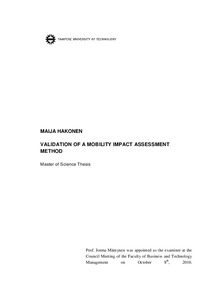Validation of a Mobility Impact Assessment Method
Hakonen, Maija (2011)
Hakonen, Maija
2011
Tietojohtamisen koulutusohjelma
Teknis-taloudellinen tiedekunta - Faculty of Business and Technology Management
This publication is copyrighted. You may download, display and print it for Your own personal use. Commercial use is prohibited.
Hyväksymispäivämäärä
2011-04-06
Julkaisun pysyvä osoite on
https://urn.fi/URN:NBN:fi:tty-201104141254
https://urn.fi/URN:NBN:fi:tty-201104141254
Tiivistelmä
Mobility is willingness to move along with potential and realized movement rather than just physical movement of vehicles, people and goods. Along with transport and infrastructure it encompasses people’s and road users’ attitudes, opinions and choices in their daily travelling and movement. The concept of mobility is hard to fully define, and has often been reduced to transport or confused with accessibility or efficiency.
This study was carried out as part of a Finnish large-scale field operational test under the TeleFOT project. In this study the correspondence of 63 Finnish test participants’ travel data from travel diaries and user-activated data loggers were analysed. Travel diaries were fully answered on average in 96.3% of travel diary (TD) entries; 68.4% of travel diary trips were made as the driver of a car or van. Trip end time correspondence in data sets had the lowest percentages, as more TD markings could have been made by estimation. The two data gathering modes did not work well together, as only 55.9% of journeys were found from both data. Moreover, 18.0% of logged trips were fragmented, compromising the reliability of the logger data results.
Based on the results of this study, the average Nordic test participant tends to be quite scrupulous and meticulous when dealing with TD, but there was a divergence with the use of data loggers. The results of TD–logger data correspondence divided participants into three groups: “good”, “mediocre” and “poor” corresponding to their performance on data matching of trip start time, trip end time, trip duration and length. /Kir11
This study was carried out as part of a Finnish large-scale field operational test under the TeleFOT project. In this study the correspondence of 63 Finnish test participants’ travel data from travel diaries and user-activated data loggers were analysed. Travel diaries were fully answered on average in 96.3% of travel diary (TD) entries; 68.4% of travel diary trips were made as the driver of a car or van. Trip end time correspondence in data sets had the lowest percentages, as more TD markings could have been made by estimation. The two data gathering modes did not work well together, as only 55.9% of journeys were found from both data. Moreover, 18.0% of logged trips were fragmented, compromising the reliability of the logger data results.
Based on the results of this study, the average Nordic test participant tends to be quite scrupulous and meticulous when dealing with TD, but there was a divergence with the use of data loggers. The results of TD–logger data correspondence divided participants into three groups: “good”, “mediocre” and “poor” corresponding to their performance on data matching of trip start time, trip end time, trip duration and length. /Kir11
